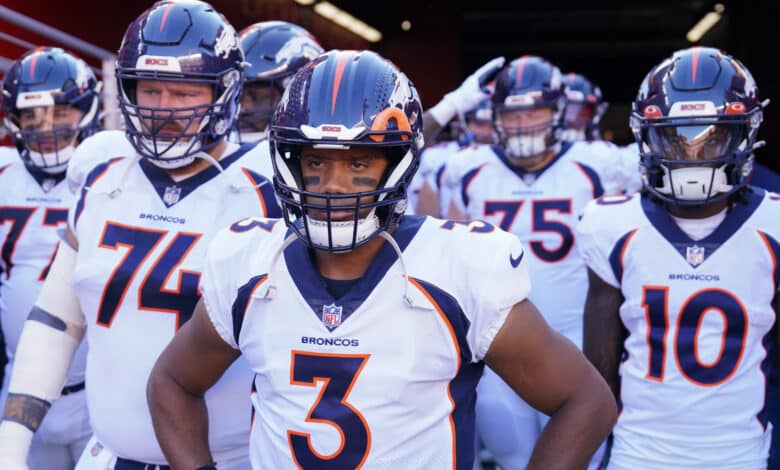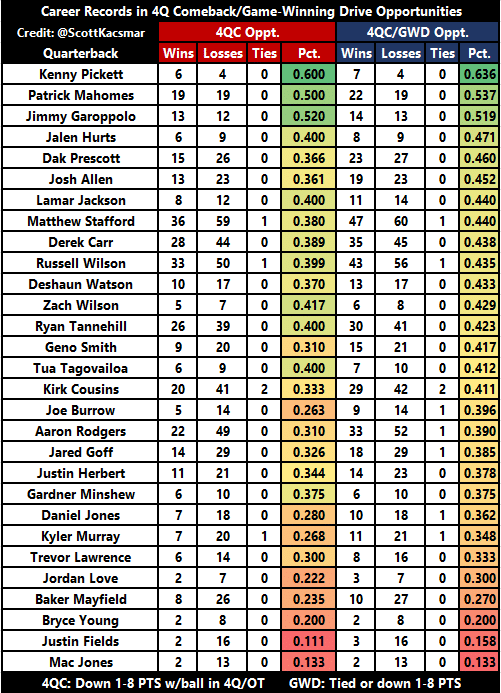Will the Pittsburgh Steelers Fix Russell Wilson or Justin Fields in Bold QB Approach?

By Scott Kacsmar
It is hard for NFL teams to admit they made a mistake. The Pittsburgh Steelers especially value their franchise’s consistency with three head coaches since 1969 and not having a losing season in the last 20 years.
But despite making the playoffs again in 2023, the Steelers rarely looked the part of a good team, and most of that was due to the quarterback position. Kenny Pickett and Mitch Trubisky struggled, and it was only when the team turned to third-stringer Mason Rudolph in December that things started to look better.
But after another playoff loss, it was clear something needed to change. Instead of bringing that quarterback room back for another difficult year in 2024, the Steelers cleaned house in one of the most stunning quarterback room transformations in NFL history:
- Trubisky was released early in the offseason, allowing him to sign with Buffalo.
- Rudolph, the playoff game starter, signed as a backup with the Titans in free agency.
- After Denver released Russell Wilson and took on a record $85 million in dead cap money over the next two seasons, the Steelers jumped on the opportunity by signing Wilson to a 1-year contract worth just $1.2 million.
- Not taking the Wilson news well, Pickett was traded to Philadelphia along with a fourth-round pick in exchange for a third-round pick and two seventh-round picks in 2025.
- Just hours later, the Steelers announced they acquired Justin Fields from Chicago for just a conditional sixth-round pick in 2025.
Wow, they killed Kenny just like that.
It is not in Pittsburgh’s nature to cut ties with a first-round pick after just two seasons, but Pickett was not getting the job done, and now he is still just a backup behind Jalen Hurts in Philadelphia instead of staying to compete with Wilson, who is a decade older than Hurts. Bold strategy, Ken.
In the end, the Steelers acquired a couple of veteran quarterbacks and only had to take on a $1.2 million contract and give up a sixth-round pick in 2025. These moves basically carry no risk, and it gives the Steelers two shots at finding their next franchise quarterback to replace Ben Roethlisberger.
But how might these moves work out in 2024? There is a possibility the Steelers are back on the quarterback market a year from now if Wilson and Fields do not perform well this season. Let’s take a look at what we might see from this bold strategy, an uncharacteristic move by Pittsburgh to say the least.
Russell Wilson Has Been Like Ben Roethlisberger His Whole Career, But Can He Replace Him in Pittsburgh?
It is so amusing to see Russell Wilson try to resurrect his career in his 13th season in Pittsburgh, which recently had Ben Roethlisberger at that position for 18 years.
If you could compare any quarterback in NFL history to Roethlisberger, Wilson would be hands down the best comparison. If you’ve forgotten just how good Wilson was in Seattle all those years, just look at all the similarities they have shared over the years:
- Both were overshadowed by the other rookie quarterbacks in their class (Eli Manning and Philip Rivers for Roethlisberger, Andrew Luck and Robert Griffin III for Wilson), but they went on to have the best careers in their draft class.
- Both had instant rookie success on teams that could run the ball with workhorse backs (Jerome Bettis and Marshawn Lynch) and play great defense with defensive-minded coaches (Bill Cowher and Pete Carroll).
- Both rookie quarterbacks were highly efficient as low-volume passers with high passer ratings and yards per pass attempt figures as they were very good at throwing intermediate and deep passes.
- Both later proved they could maintain their efficiency numbers with greater volume of passing while still making the playoffs with teams after their elite scoring defenses declined to mediocre levels.
- Both showed right away they could extend plays and make “backyard football” plays off script, which often led to some of their best plays, but they also both took more sacks than other elite quarterbacks as they held the ball longer to make things happen.
- Roethlisberger (554) and Wilson (527) both rank among the top 5 in sacks taken in NFL history.
- Both showed a flair for the dramatic with at least 5 game-winning drives as rookies.
- Both maintained this throughout their careers with Roethlisberger (53) and Wilson (39) among the top 10 quarterbacks in game-winning drives in the regular season.
- Both were great in two-minute drills, running the hurry-up offense.
- Both always clamored for more no-huddle offense but were always denied by their coaches.
- Neither ran the quarterback sneak that often.
- Both won a playoff game as rookies before losing their second game.
- Both made subtle improvements to their game in their second seasons, helping their team to a Super Bowl win (2005 Steelers and 2013 Seahawks).
- Both enjoyed the early success of a ring that would shield them for criticism for later playoff failures.
- Both lost their last Super Bowl appearance, coming up short on the final drive: Roethlisberger against the 2010 Packers and Wilson against the 2014 Patriots (threw the costliest interception in NFL history from the 1-yard line).
- Despite their early playoff success, both threw a lot of bad interceptions in the postseason, and they only made one appearance in the Conference Championship Round in the back half of their career.
- The early stigma of being on a “run the ball and play great defense” team led to many not viewing them in the same class as Tom Brady, Peyton Manning, Aaron Rodgers, Drew Brees, and neither Roethlisberger nor Wilson ever received an MVP vote or was named an All-Pro quarterback in their careers.
- Roethlisberger and Wilson are the only quarterbacks to start their careers in the salary cap era (1994), make multiple Super Bowl starts, win at least one Super Bowl, and never win a Super Bowl MVP award.
That is a lot to have in common, but for Pittsburgh’s sake, there is one glaring difference between these two.
When Roethlisberger turned 30 in 2012, he and the Steelers realized he needed to change his playing style to preserve his body for a longer career. He was taking too many sacks and hits under Bruce Arians’ offensive scheme, so the team hired Todd Haley as the offensive coordinator in 2012. Roethlisberger cut down his sacks and hits by getting rid of the ball faster, and while he didn’t have a perfect attendance record, he usually avoided serious injuries outside of 2019 when he needed elbow surgery.
But Roethlisberger had a dramatic transformation with his sack numbers. In 2004-11, his sack rate was 8.66%. For his last decade, he nearly cut that half in 4.47%. He was getting rid of the ball maybe too quickly at the end of his career after the surgery, but that was to compensate for the loss of arm strength and the fact that old quarterbacks don’t want to be hit anymore. They had their share and older bodies don’t heal as quickly.
But Wilson has not made this adjustment even though he turns 36 years old this year. He still holds onto the ball long and takes his share of sacks. In fact, Wilson took a league-high 55 sacks in 2022 with Denver, and his sack rate was still high at 9.1% last season. His sack rate in Denver (9.7%) was higher than it was in Seattle (8.3%).
According to Next Gen Stats, Wilson’s average time to throw in 2023 was 3.06 seconds. The only starting quarterback to hold the ball longer was actually Justin Fields (3.23 seconds), so expect the Steelers to take more sacks this year.
At 36, it seems very unlikely that Wilson is going to alter his game drastically the way Roethlisberger once did. We’ll see if that costs him a gold jacket or not because for what was once a Hall of Fame career for Wilson, he needs to show something here or he risks going the Donovan McNabb path and never making it to Canton. McNabb fell apart after the Eagles traded him to Washington in 2010.
Wilson could be on that same path if things don’t work out here.
Justin Fields Is the Total Opposite of Kenny Pickett
While we just favorably compared Wilson to Roethlisberger, Justin Fields, and Kenny Pickett could not be more different as NFL quarterbacks. This has its pros and cons for Pittsburgh.
The great news is Fields actually has thrown multiple touchdowns in multiple weeks in a row in his career. Last season, Fields threw 4 touchdowns in back-to-back games against Washington and Denver. Pickett has just 13 touchdown passes in 25 career games, and his 1.8% touchdown pass rate is the lowest in NFL history (min. 500 passes).
The good news is Fields is way more mobile than Pickett, who would often try spinning right into the pass rush and did not show good scrambling ability. Fields is fast and had one of the greatest rushing seasons for a quarterback in NFL history when he rushed for 1,143 yards. He had 3 touchdown runs of 55 yards in that season alone. We didn’t see this as much in 2023, but Fields did rush for 104 yards in a game against the Lions.
The bad news is Fields, who holds the ball too long, takes an alarming number of sacks, which are often drive killers. Fields’ career sack rate is 12.4%, the third highest in the NFL since 1970 (min. 500 passes), and that is nearly double the career sack rate for Pickett (6.6%). This is absolutely more of a quarterback stat than an offensive line stat. Last season in Chicago, undrafted rookie quarterback Tyson Bagent’s sack rate was just 3.4% playing behind the same offensive line.
The terrible news for Pittsburgh is Pickett was surprisingly clutch in close games, and Fields is in the running for the worst quarterback in NFL history with the game on the line. Pickett is 7-4 (.636) at game-winning drive opportunities when he had the ball in a tied or one-score deficit game (1-to-8 points) in the fourth quarter or overtime. Fields is just 3-16 (.158) in those situations. Pickett’s record is the best among active quarterbacks (min. 10 games) and Fields’ record is next to last.
You could call him Kenny “OneDrive” Pickett because if he only needed to score one touchdown to win the game, he wasn’t bad at doing it. Meanwhile, Fields was a nightmare in games even if he just had to set up a field goal attempt in a 3-point game.
In a loss to Wilson’s Broncos last year, Fields coughed up a game-tying touchdown on a fumble in the fourth quarter, then later threw a game-ending interception from midfield when Chicago trailed 31-28. That’s not to say Fields was the main reason his team lost every time, but he cannot be trusted at all in a close game.
This is a huge deal since Mike Tomlin’s Steelers have been feasting on close games for years. Most of their wins since 2021 are in games where they score the winning points in the fourth quarter or overtime.
Fortunately, Wilson embraces these clutch moments, and you can see his career records in these moments are respectable even if the last few years have not gone as well as his past did.
How Does Arthur Smith’s Offense Factor in Here?
The Steelers are no longer able to blame offensive coordinator Matt Canada for their offensive woes. They fired him last November, though the scoring was still a struggle until Rudolph took over for those final games.
But in 2024, the Steelers are going with Arthur Smith, who was Atlanta’s head coach since 2021. He underperformed there, often struggling to find use for tight end Kyle Pitts despite a high draft pick, and you could argue he didn’t do much of anything to elevate his quarterbacks (an aging Matt Ryan, a reclamation project in Marcus Mariota, and a young player in Desmond Ridder) in Atlanta.
We talked about the sacks Wilson and Fields are likely to take, and Smith’s offense is not likely going to be the remedy for that weakness. Even in Tennessee in 2019 when Ryan Tannehill had his breakout moment with Smith calling the offense, Tannehill’s sack rate was 9.8%. He got that down to 4.8% in 2020 with a full offseason to prepare under Smith, though that was also the COVID year where offensive numbers were at an all-time high in empty stadiums.
But Smith’s offense likes play-action passes, asking the quarterback to turn his back to the pass rush, and to hold the ball longer for deep shots set up by running the ball frequently. It wasn’t that hard in Tennessee to call plays when you could hand off to Derrick Henry before throwing deep to A.J. Brown.
But in Pittsburgh, the Steelers are going to try feeding Najee Harris, who is far from Henry, and the offensive line may still not be up to par either. That could be an area they improve in the draft next month, and it might have to be a top priority at that.
By running the ball frequently on early downs, you can expect Wilson (or Fields) to be in third-down passing situations often, which is another situation where you can expect to hold the ball a little longer than average.
Ideally, Wilson is more cut out for this Smith offense than Fields is. Wilson can get the ball deep to George Pickens, and he would be better in this offense than Pickett, who was too conservative and afraid to throw interceptions after throwing a ton of them to start his rookie season. Wilson can still get that rainbow arc on the deep balls and should hit some big plays.
But he is definitely going to take his share of sacks, and Smith is going to learn quickly that Harris behind this line is not on par with the 2019-20 Titans and King Henry. The Steelers also need to acquire another receiver after trading Diontae Johnson, their best route runner, to the Panthers.
Finally, will Smith even acknowledge tight end Pat Freiermuth after the Kyle Pitts fiasco in Atlanta? The Steelers already had issues with not throwing to Freiermuth enough despite him showing promise each year. We’ll see if that continues with the tight end going into a contract year.
Conclusion: What to Expect This Season and Beyond?
The Steelers have already discussed doing a long-term deal with Wilson later this year. Hold your horses, guys. Let’s see if this thing looks workable first. New general manager Omar Khan has shown some more aggressive tendencies than his predecessor Kevin Colbert did, but the Steelers can’t rush into a big contract for an older quarterback off a small sample size of games.
For all we know, Wilson does complete his Donovan McNabb arc, who in 2011 was benched after a few games for rookie Christian Ponder. Maybe we see Fields take over in October because Wilson is definitely the Week 1 starter barring something disastrous.
But the Steelers are in a pickle with Fields too, because they have to decide by May if they want to pick up his fifth-year option ($25.6 million) for 2025. That’s before they even get a look at him in training camp. Otherwise, Fields will be a free agent after this season, a season in which he could ride the bench all year if Wilson plays well and stays healthy.
Pittsburgh’s best bet would probably be to decline the fifth-year option, start Wilson, and see what happens there. Maybe Fields will wake up and realize the trade market for him this year was absolutely dead, so his best bet is to stay in Pittsburgh with a stable organization, even if it means taking a lower deal to stay on as Wilson’s backup for 2025.
But with the way Wilson takes sacks and is getting older, you never know if Fields won’t start multiple games this year and get a shot to show something more than he did in Chicago.
This all could easily backfire on the Steelers and see both quarterbacks disappoint too. Maybe Wilson is just washed and maybe Fields is just never going to be a star in this league.
But taking such a low-risk opportunity to see if either can beat the odds and shine is still very much worth it for Pittsburgh. It sure beats another offseason of asking if Pickett can throw 15 touchdowns this season. The Steelers gave the local kid a shot and two years was enough to say “Our bad.”
Welcome to NFL decision-making in the 21st century, Pittsburgh.




